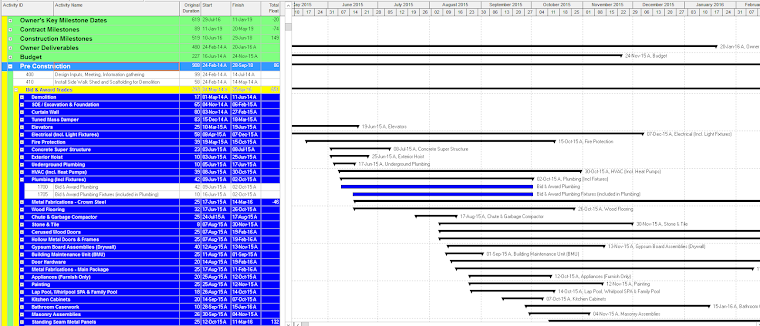Class 109: Gantt Charts
WHAT IS A GANTT CHART?
A Gantt Chart is a
type of bar chart that provides a graphical representation of a project that
includes the activities that make up the project. The activities, represented as bars, are time
scaled and show activity ID, description, duration, start and finish dates, and
an overall sequencing of the flow of work.1
Example of a Gantt Chart:
The example above shows a
typical construction schedule. The left half of the schedule identifies
important information in the WBS; information such as start and finish dates, activity
durations and total float for each activity. The right half of the schedule displays
the Gantt chart. The rectangular horizontal
bars represent activities. The red bars
identify forecasted critical activities, the green bars identify forecasted
activities with positive float, and the blue bars identify activities that have
been completed. The diamonds are
milestones and typically represent important contractual items, such as
substantial completion. The yellow bars
and diamonds identify dates from the attached baseline schedule. The varying
lengths represent the activity durations. The activity bars are logically tied to other activities or
milestones.
Additionally, a time
scale is applied to the Gantt Chart, which provides the viewer a sense of the
amount of work remaining at any point in time and can help prioritize
completion of the work. With activity
names noted beside the activity bars, a simplistic view allows for a quick and
easy review of the schedule.
What are some other reasons
to have a Gantt chart?
Gantt charts can help
identify how many resources are required to complete the project. For example, overlapping bars indicate
activities that will be executed at the same time and will require multiple
resources to complete.
Gantt charts can also be
used to identify various risks in execution. For example, activities with very
long durations, identified in the Gantt chart by long uninterrupted horizontal bars,
are likely made up of multiple smaller activities that are logically tied but not
broken out in the schedule. If any of
the smaller activities are delayed, the larger bar’s duration is extended. Since the activities are summarized by one
long bar rather than shorter specific activities, it would be difficult to
identify the specific event causing delay within the summary activity. From
reviewing the Gantt chart and noticing the summary activity, project schedulers
can break out the summary activity into more detail and avoid future issues
with analyzing project delays.
Gantt Chart Summary:
1. Gantt charts graphically represent a construction schedule.
2. Gantt charts make it easier to identify schedule risks and can help create a mitigation strategy.
Key Terms:
Construction Schedule - a comprehensive and realistic plan that represents the specific activities, reasonable duration for the activities, and the planned sequence of work for the project
Logic - Relationship describing the interdependency of starts and finishes between activities or events
Resources:
1. AACE International Recommended Practice. 91-R16: Schedule Development AACE International Recommended Practice https://web.aacei.org/docs/default-source/vl-papers/22776.pdf








0 comments: